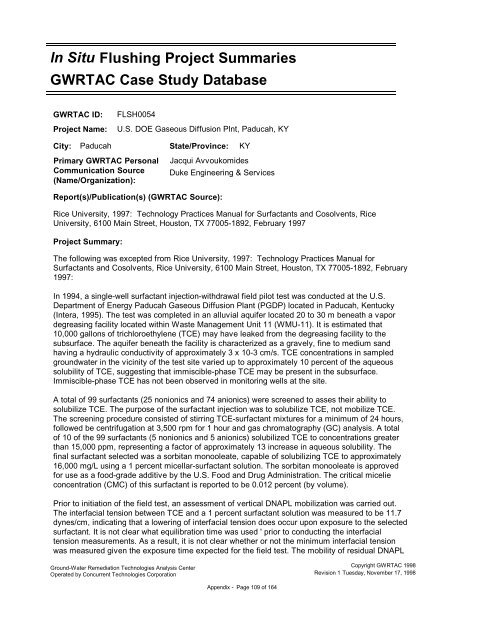Technology Status Report: In Situ Flushing - CLU-IN
Technology Status Report: In Situ Flushing - CLU-IN
Technology Status Report: In Situ Flushing - CLU-IN
You also want an ePaper? Increase the reach of your titles
YUMPU automatically turns print PDFs into web optimized ePapers that Google loves.
<strong>In</strong> <strong>Situ</strong> <strong>Flushing</strong> Project Summaries<br />
GWRTAC Case Study Database<br />
GWRTAC ID: FLSH0054<br />
Project Name: U.S. DOE Gaseous Diffusion Plnt, Paducah, KY<br />
City: Paducah State/Province: KY<br />
Primary GWRTAC Personal<br />
Communication Source<br />
(Name/Organization):<br />
Project Summary:<br />
Jacqui Avvoukomides<br />
Duke Engineering & Services<br />
<strong>Report</strong>(s)/Publication(s) (GWRTAC Source):<br />
Rice University, 1997: <strong>Technology</strong> Practices Manual for Surfactants and Cosolvents, Rice<br />
University, 6100 Main Street, Houston, TX 77005-1892, February 1997<br />
The following was excepted from Rice University, 1997: <strong>Technology</strong> Practices Manual for<br />
Surfactants and Cosolvents, Rice University, 6100 Main Street, Houston, TX 77005-1892, February<br />
1997:<br />
<strong>In</strong> 1994, a single-well surfactant injection-withdrawal field pilot test was conducted at the U.S.<br />
Department of Energy Paducah Gaseous Diffusion Plant (PGDP) located in Paducah, Kentucky<br />
(<strong>In</strong>tera, 1995). The test was completed in an alluvial aquifer located 20 to 30 m beneath a vapor<br />
degreasing facility located within Waste Management Unit 11 (WMU-11). It is estimated that<br />
10,000 gallons of trichloroethylene (TCE) may have leaked from the degreasing facility to the<br />
subsurface. The aquifer beneath the facility is characterized as a gravely, fine to medium sand<br />
having a hydraulic conductivity of approximately 3 x 10-3 cm/s. TCE concentrations in sampled<br />
groundwater in the vicinity of the test site varied up to approximately 10 percent of the aqueous<br />
solubility of TCE, suggesting that immiscible-phase TCE may be present in the subsurface.<br />
Immiscible-phase TCE has not been observed in monitoring wells at the site.<br />
A total of 99 surfactants (25 nonionics and 74 anionics) were screened to asses their ability to<br />
solubilize TCE. The purpose of the surfactant injection was to solubilize TCE, not mobilize TCE.<br />
The screening procedure consisted of stirring TCE-surfactant mixtures for a minimum of 24 hours,<br />
followed be centrifugation at 3,500 rpm for 1 hour and gas chromatography (GC) analysis. A total<br />
of 10 of the 99 surfactants (5 nonionics and 5 anionics) solubilized TCE to concentrations greater<br />
than 15,000 ppm, representing a factor of approximately 13 increase in aqueous solubility. The<br />
final surfactant selected was a sorbitan monooleate, capable of solubilizing TCE to approximately<br />
16,000 mg/L using a 1 percent micellar-surfactant solution. The sorbitan monooleate is approved<br />
for use as a food-grade additive by the U.S. Food and Drug Administration. The critical micelie<br />
concentration (CMC) of this surfactant is reported to be 0.012 percent (by volume).<br />
Prior to initiation of the field test, an assessment of vertical DNAPL mobilization was carried out.<br />
The interfacial tension between TCE and a 1 percent surfactant solution was measured to be 11.7<br />
dynes/cm, indicating that a lowering of interfacial tension does occur upon exposure to the selected<br />
surfactant. It is not clear what equilibration time was used ' prior to conducting the interfacial<br />
tension measurements. As a result, it is not clear whether or not the minimum interfacial tension<br />
was measured given the exposure time expected for the field test. The mobility of residual DNAPL<br />
Ground-Water Remediation Technologies Analysis Center<br />
Operated by Concurrent Technologies Corporation<br />
Appendix - Page 109 of 164<br />
Copyright GWRTAC 1998<br />
Revision 1<br />
Tuesday, November 17, 1998
















